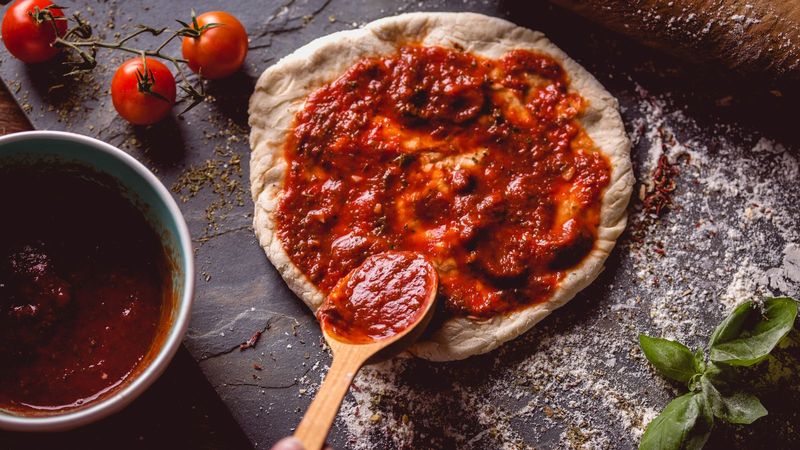Pizza, a global sensation, boasts diverse styles from Neapolitan thin-crust to Chicago's deep-dish delights. Beyond toppings and crusts, the sauce reigns supreme, defining its essence. Perfecting the best pizza sauce at home heightens your culinary skills, delivering an authentic taste that resonates with every bite.
The storied history of pizza traces back to ancient civilizations, with its roots deeply embedded in the vibrant culinary traditions of Mediterranean cultures. Originating in Naples, Italy, during the 18th century, pizza emerged as a humble street food, crafted by local artisans and bakers seeking to transform simple ingredients—dough, tomatoes, mozzarella cheese, and olive oil—into a flavorful sensation. Its evolution from a regional delicacy to a global phenomenon is a testament to its irresistible allure and adaptability. Immigrants from Italy introduced pizza to the United States in the late 19th and early 20th centuries, sparking a culinary revolution that transcended borders, cultures, and palates. Today, pizza stands as a beloved dish celebrated worldwide, embodying innovation, tradition, and the timeless appeal of a culinary masterpiece that continues to captivate hearts, minds, and taste buds across generations.
The best pizza sauce ingredients

San Marzano tomatoes: Opt for high-quality San Marzano tomatoes, renowned for their sweet, rich flavour and low acidity, providing a perfect base for your pizza sauce.
Garlic: Fresh garlic cloves minced or finely chopped, infusing the sauce with aromatic, pungent notes that enhance depth and complexity.
Olive oil: Extra virgin olive oil adds a fruity, peppery flavour, enriching the sauce's texture and providing a smooth, luxurious consistency.
Basil: Fresh basil leaves or dried basil impart herbal, slightly sweet undertones, contributing to the sauce's vibrant colour and aromatic profile.
Salt and pepper: Season with kosher salt and freshly ground black pepper to balance flavours, enhance sweetness, and add subtle heat.
Red pepper flakes (optional): For a hint of spice and complexity, consider adding red pepper flakes, providing a subtle kick that elevates the sauce's flavour profile.
Method of making the best pizza sauce at home

- Preparation: Start by draining the San Marzano tomatoes, removing excess liquid, and retaining the tomatoes' flavorful essence.
Sautéing the garlic: In a saucepan, heat olive oil over medium heat, add minced garlic, and sauté until fragrant, ensuring not to brown or burn the garlic. - Tomato tales: Add the drained San Marzano tomatoes to the saucepan, breaking them down using a wooden spoon or spatula, releasing their natural juices and flavours.
- Seasoning and simmering: Season the sauce with salt, pepper, and optional red pepper flakes, stirring well to combine. Add fresh or dried basil leaves, reduce the heat to low, and let the sauce simmer gently, allowing flavours to meld and intensify.
- Mashing and mixing: Using a potato masher or immersion blender, gently mash or blend the sauce to achieve your desired consistency, ensuring a harmonious blend of textures and flavours.
- Taste and adjust: Taste the sauce, adjust seasoning as needed, and simmer for an additional 10-15 minutes to achieve optimal flavour development.
- Cooling and storing: Allow the pizza sauce to cool completely before using it as a flavorful base for your pizzas. Store any remaining sauce in an airtight container in the refrigerator for up to one week or freeze it for future use.
How to make pizza sauce without garlic and onion
To craft a flavorful pizza sauce without onion and garlic, begin by heating olive oil in a saucepan over medium heat. Add finely chopped carrots, celery, and bell peppers to create a fragrant base. Sauté until softened before incorporating crushed tomatoes, dried basil, oregano, salt, and a pinch of red pepper flakes for added depth and spice. Allow the mixture to simmer gently, melding the flavours to perfection. Finish with a drizzle of extra-virgin olive oil and a splash of balsamic vinegar to enhance the sauce's richness and complexity. Adjust seasoning as needed, and blend the sauce to achieve a smooth consistency, creating a delightful pizza sauce without onion and garlic that celebrates vibrant flavours.
How to make white pizza sauce

To craft a creamy white pizza sauce, start by melting unsalted butter in a saucepan over medium heat. Whisk in all-purpose flour to create a smooth roux, cooking for a minute to eliminate any raw flour taste. Gradually pour in whole milk while continuously whisking to prevent lumps, allowing the mixture to thicken.
Add some salt, pepper, and a touch of nutmeg to deepen the flavour profile. Reduce the heat and simmer gently until the sauce reaches a creamy consistency. Take it off the heat and blend in grated Parmesan cheese until it melts seamlessly into the mixture. Allow the white pizza sauce to cool slightly before spreading it generously over your pizza dough, complementing toppings with its rich, velvety texture and savoury notes.
Best pizza variations from across the world

Each of these pizza variations showcases unique ingredients, preparation techniques, and regional influences, contributing to the rich tapestry of global pizza culture and delighting enthusiasts worldwide. Here are seven of the most famous pizza variations recognized globally.
- Neapolitan Pizza: Originating from Naples, Italy, it features a thin crust, simple tomato sauce, fresh mozzarella cheese, fresh basil leaves, and extra-virgin olive oil.
- Margherita Pizza: A classic Neapolitan pizza topped with tomatoes, mozzarella cheese, fresh basil, salt, and olive oil, representing the colours of the Italian flag—red, white, and green.
- Chicago Deep-Dish Pizza: Known for its deep, thick crust, it features layers of cheese, toppings, and chunky tomato sauce, baked in a deep-dish pan, creating a hearty, indulgent pie.
- New York-Style Pizza: Characterised by its large, thin, and foldable slices, this pizza features a hand-tossed crust, tangy tomato sauce, and generous cheese coverage, perfect for on-the-go dining.
- Sicilian Pizza: Originating from Sicily, Italy, it boasts a thick, rectangular crust, topped with robust tomato sauce, onions, anchovies, herbs, and a generous sprinkling of cheese, offering a delightful contrast of textures and flavours.
- Greek Pizza: Featuring a thick, chewy crust, it is topped with a blend of cheeses, typically mozzarella and feta, along with tomatoes, olives, onions, bell peppers, and a hint of oregano, reflecting Greek culinary influences.
- California-Style Pizza: Inspired by California's fresh produce and innovative culinary scene, this pizza features a thin crust topped with unconventional ingredients like barbecue sauce, chicken, avocado, goat cheese, and arugula, blending diverse flavours and textures.




